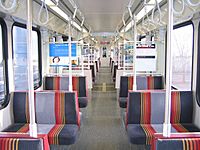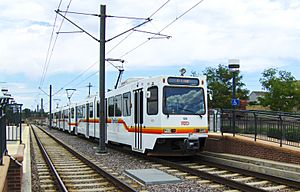RTD bus and rail services facts for kids
Quick facts for kids RTD |
|||
|---|---|---|---|
 Denver LRVs in snow, on Stout St in downtown.jpg |
|||
| Info | |||
| Owner | Regional Transportation District | ||
| Locale | Denver Metropolitan Area | ||
| Transit type | Bus Commuter rail Light rail |
||
| Number of lines | 127 (Bus) 4 (Commuter rail) 6 (Light rail) |
||
| Number of stations | 57 (Light rail) 21 (Commuter rail) |
||
| Headquarters | 1660 Blake Street Denver, Colorado |
||
| Operation | |||
| Began operation | 1969 (Bus) 1994 (Light rail) 2016 (Commuter rail) |
||
| Reporting marks | RTDC, RTDZ | ||
| Number of vehicles | 1,026 (Bus) 267 (Rail) |
||
| Technical | |||
| System length | 113.1 mi (182.0 km) (60.1 mi (96.7 km) light rail, 53 mi (85 km) commuter rail) | ||
| Track gauge | 4 ft 8 1⁄2 in (1,435 mm) standard gauge | ||
| Electrification | Overhead line, 750 V DC (light rail) or 25 kV 60 Hz AC (commuter rail) | ||
|
|||
RTD Bus and Rail (also called TheRide) is a public transportation system. It serves the Denver, Colorado, metropolitan area. The Regional Transportation District (RTD) operates this system. It includes many bus routes and several light rail and commuter rail lines. There are 78 stations and 113.1 miles (182.0 km) of track.
Contents
History of Denver's Public Transit
Early Bus Services
Bus service in Denver started in 1924. The first bus ran between Englewood and Fort Logan. By 1950, buses had completely replaced the old streetcar system. However, more people were using cars, so fewer people rode the buses.
In 1969, the Regional Transportation District (RTD) was created. Its goal was to provide public transportation to more counties around Denver. RTD bought private bus companies. It also made bus service better and added new routes.
In 1974, Denver Metro Transit joined RTD. After this, more and more people started using public transit.
Light Rail System
RTD's first light rail line opened on October 7, 1994. This section is now part of the D Line and L Line. The first weekend, over 200,000 people rode the new system for free.
Since then, RTD has opened more light rail lines. An extension to Littleton opened in 2000. Another extension to Denver Union Station opened in 2002. In 2006, a large extension called the T-REX project was finished. This added 19-mile (31 km) of new track.
By April 2013, the light rail system had 170 vehicles. They ran on 47 miles (76 km) of track.
Commuter Rail System
RTD began planning commuter rail lines with the FasTracks project. The first commuter rail line, the A Line, opened on April 22, 2016. This line connects Denver Union Station to Denver International Airport.
New safety systems, like Positive Train Control (PTC), are used on these lines. After the A Line opened, there were some issues with crossing signals. RTD worked to fix these problems. The B Line opened in July 2016. The G Line to Wheat Ridge opened on April 26, 2019.
Transit Incidents
On January 28, 2019, an R Line light rail train went off its tracks. This happened near East Exposition Avenue and South Sable Boulevard. The train was going too fast for the curve. Several passengers were injured.
On September 21, 2022, another derailment happened at the same spot. Three people were taken to the hospital with injuries. The cause of this accident was investigated.
RTD's Current Services
Main Transit Services
RTD offers regular bus and rail services. Bus routes are either Local or Regional.
Rail services use four fare zones: A, B, C, and Airport. Local travel is within two zones. Regional travel covers all three lettered zones. The Airport zone is for trips to and from Denver International Airport.
Rail Lines Available
The current commuter rail lines are:
- A Line: Connects Union Station to Denver International Airport.
- B Line: Runs from Union Station to Westminster.
- G Line: Goes from Union Station to Wheat Ridge/Ward.
- N Line: Travels from Union Station to Eastlake/124th.
The current light rail lines are:
- D Line: Connects Downtown Denver to Littleton/Mineral.
- E Line: Runs from Union Station to RidgeGate.
- H Line: Goes from Downtown Denver to Florida.
- L Line: Connects Downtown Denver to 30th/Downing.
- R Line: Travels from Peoria to RidgeGate (partially suspended).
- W Line: Runs from Union Station to Jefferson County Government Center–Golden.
Special Transit Services
RTD also offers special bus services for different needs.
- Access-a-Ride: This service helps people with disabilities who cannot use regular buses or trains.
- FlexRide: An on-demand shuttle for areas without regular bus or rail service. It connects people to nearby transit hubs.
- Flatiron Flyer: An express bus service between Boulder and Denver.
- Free MallRide: A free shuttle bus that runs along the 16th Street Mall. It connects major RTD hubs.
- Free MetroRide: A free shuttle that runs faster than the MallRide. It makes fewer stops between Union Station and Civic Center Station.
- SeniorRide: Shuttles for groups of seniors. It also has scheduled trips to shopping centers and senior housing.
- SkyRide: An express bus service for travelers going to Denver International Airport.
- Sporting Events Service:
- "BroncosRide" provides direct service to Broncos Stadium at Mile High.
- "RunRide" offers service to Boulder during the Bolder Boulder 10K race.
RTD Stations
Major Bus Stations
Major bus stations are key points for express and regional bus routes. It is easy to transfer between routes at these stations.

| Station Name | Address |
|---|---|
| Civic Center Station | 1550 Broadway, Denver |
| Union Station (rail and bus) | 1701 Wynkoop Street, Denver |
| Downtown Boulder Station | 1400 Walnut Street, Boulder |
Rail Stations
Many light rail and commuter rail stations also have bus services. As of 2018, there are 55 stations on the RTD Rail system. RTD designs its stations carefully. They focus on the platform, ticket areas, and how people can access the station.
All stations also feature public art. This art is part of RTD's "Art-n-Transit" program. You can find art in canopies, columns, and even the landscaping.
Park-n-Ride Locations
Many RTD rail stations and bus stops have special parking areas. These are called Park-n-Ride facilities. As of 2014, there are over 70 Park-n-Ride locations. They offer more than 30,000 parking spaces.
Future Transit Plans
RTD plans to extend several light rail and commuter rail lines. These extensions are part of the FasTracks project. There are also plans for a Bus Rapid Transit (BRT) line on East Colfax Avenue.
Art in the Light Rail System
In 1977, Colorado passed a law about public art. It requires that 1 percent of state construction budgets go to art. About $1 million from the T-REX project was used for art at 13 new light rail stations. This was part of RTD's "Art-n-Transit" program.
Some of the artists and their works include:
- Ira Sherman, "Stange Machine," at Louisiana/Pearl Station.
- Ries Niemi, "Big Boots," at Colorado Station.
- John Goe, "Reflective Discourse," at University Station.
- Gregory Gove, "Connected," at Yale Station.
- Chris Janney, "Harmonic Pass: Denver," at Southmoor Station.
- Richard Elliott, "Thunder Over the Rockies," at Belleview Station.
- Christopher Weed, "Windswept," at Dayton Station.
- Dwight Atkinson, "Yet Another Way To Know That Nature Will Eventually Win," at Nine Mile Station.
- Wopo Holup, "Orchard Memory," at Orchard Station.
- Michael Clapper, "Nucleus," at Arapahoe at Village Center Station.
- John McEnroe, "Fools Gold," at Dry Creek Station.
- Emmett Culligan, "Plow," at County Line Station.
- Ray King, "Sun Stream," at Lincoln Station.
Artists Susan Cooper and Rafe Ropek also worked on designs for benches, railings, and canopies at all stations.
Images for kids
See also
 In Spanish: Tren Ligero de Denver para niños
In Spanish: Tren Ligero de Denver para niños




